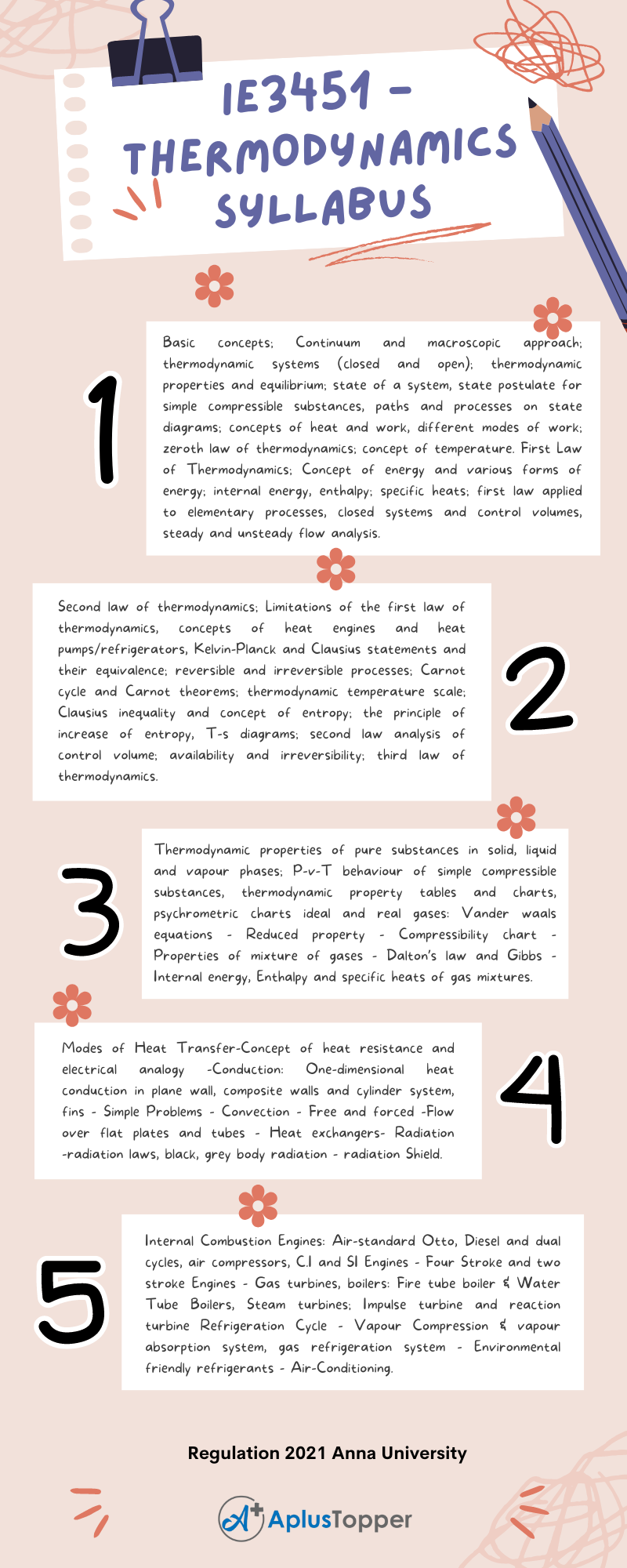Subject code IE3451 deals with semester IV of the Thermodynamics Syllabus of Anna University based on regulation 2021. In this article, we would like to discuss the syllabus of Thermodynamics. Let’s see.
We aim to provide the unit-wise IE3451 – Thermodynamics syllabus. It will avoid confusion for students during the examination period. We added the required textbooks and references to the syllabus. I hope this information is useful. You better be quick to read the syllabus prior than the others and prepare well for examinations. Kindly read this article thoroughly and then share it with your classmates. A decent qualified certificate from the university will help you to reach heights The following syllabus will assist you.
If you want to know more about the syllabus of B.E. Industrial Engineering and Management connected to an affiliated institution’s four-year undergraduate degree program. We provide you with a detailed Year-wise, semester-wise, and Subject-wise syllabus in the following link B.E. Industrial Engineering and Management Syllabus Regulation 2021 Anna University.
Aim Of Objectives:
- To explain the basic concepts of thermodynamics and the first law of thermodynamics.
- To analyze the thermodynamics’ second law.
- To assess the qualities of pure materials.
- To obtain a better understanding of mode of heat conduction, convection, and radiation.
- To apply thermodynamic concepts to IC engines, boilers, turbines, refrigeration, and air-conditioning systems.
IE3451 – Thermodynamics Syllabus
Unit – I: Basics Concepts And First Law Of Thermodynamics
Basic concepts; Continuum and macroscopic approach; thermodynamic systems (closed and open); thermodynamic properties and equilibrium; state of a system, state postulate for simple compressible substances, paths and processes on state diagrams; concepts of heat and work, different modes of work; zeroth law of thermodynamics; concept of temperature. First Law of Thermodynamics; Concept of energy and various forms of energy; internal energy, enthalpy; specific heats; first law applied to elementary processes, closed systems and control volumes, steady and unsteady flow analysis.
Unit – II: Second Law Of Thermodynamics
Second law of thermodynamics; Limitations of the first law of thermodynamics, concepts of heat engines and heat pumps/refrigerators, Kelvin-Planck and Clausius statements and their equivalence; reversible and irreversible processes; Carnot cycle and Carnot theorems; thermodynamic temperature scale; Clausius inequality and concept of entropy; the principle of increase of entropy, T-s diagrams; second law analysis of control volume; availability and irreversibility; third law of thermodynamics.
Unit – III: Properties Of Pure Substance
Thermodynamic properties of pure substances in solid, liquid and vapour phases; P-v-T behaviour of simple compressible substances, thermodynamic property tables and charts, psychrometric charts ideal and real gases: Vander waals equations – Reduced property – Compressibility chart – Properties of mixture of gases – Dalton’s law and Gibbs – Internal energy, Enthalpy and specific heats of gas mixtures.

Unit – IV: Basics Of Heat Transfer
Modes of Heat Transfer-Concept of heat resistance and electrical analogy -Conduction: One-dimensional heat conduction in plane wall, composite walls and cylinder system, fins – Simple Problems – Convection – Free and forced -Flow over flat plates and tubes – Heat exchangers- Radiation -radiation laws, black, grey body radiation – radiation Shield.
Unit – V: Applications Of Thermodynamic Cycles
Internal Combustion Engines: Air-standard Otto, Diesel and dual cycles, air compressors, C.I and SI Engines – Four Stroke and two-stroke Engines -Gas turbines, boilers: Fire tube boiler & Water Tube Boilers, Steam turbines; Impulse turbine and reaction turbine Refrigeration Cycle – Vapour Compression & vapour absorption system, gas refrigeration system – Environmental friendly refrigerants -Air-Conditioning.
Text Books:
- Cengel Y.A. and Boles M.A., “Thermodynamics an Engineering Approach”, 8th edition, McGraw hill, United States, 2017.
- Nag P.K., “Engineering Thermodynamics”, 6th edition, McGraw Hill, United States, 2017.
- Holman J.P., “Heat transfer”, 10th edition, McGraw Hill, United States 2017.
References:
- R.K. Rajput, “Engineering Thermodynamics”, 3rd Edition, Laksmi Publications, New Delhi.
- Arora C.P., “Refrigeration and Air Conditioning”, 3rd Edition, Tata McGraw Hill, United States, 2017.
- Claus Borgnakke, “Fundamentals of Engineering Thermodynamics” 8th edition, John Wiley & Sons, United States, 2013.
- Moran M.J. and Shapiro H.N., “Fundamentals of Engineering Thermodynamics”, 9th Edition, Wiley, United States, 2018.
- Radhakrishnan E., “Fundamentals of Engineering Thermodynamics”, 2nd Edition, Prentice Hall of India, 2005.
- Van Wylen and Sonntag, “Classical Thermodynamics”, 4th Edition, Wiley, United States, 1994.
Related Posts On Semester – IV:
- IE3491 – Operations Research
- AE3491 – Mechanics of Machines
- GE3451 – Environmental Sciences and Sustainability
Must Read:
